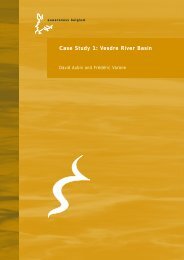Case Study 1: Matarraña River Basin - Euwareness
Case Study 1: Matarraña River Basin - Euwareness
Case Study 1: Matarraña River Basin - Euwareness
Create successful ePaper yourself
Turn your PDF publications into a flip-book with our unique Google optimized e-Paper software.
However, the severe drought kept the dialogue via opened among the basin actors.<br />
Farmers and city councils of the whole basin maintained the commission, which was<br />
broadened as the Municipality of Valderrobres (high basin) and a representative of<br />
Torre del Compte irrigation community joined it. In July, as the <strong>Matarraña</strong> river was dry<br />
in its middle and lower sections and the Pena Dam only stored 2 hm3, the farm<br />
production of the middle and lower basin became under threat again. Maella, which<br />
was the municipality that suffered more from drought effects had to impose daily<br />
restrictions in drinking water in order to save as much fruit crops as possible. There<br />
were only 800,000 m3 of water available to irrigation. Given that situation, the<br />
commission decided to meet again in order to study three possible emergency<br />
regulation projects (its costs, profitability and environmental impact) and to meet again<br />
when such projects were finished in order to make a decision about the best solution.<br />
Those projects included the lateral pools, the pumping from the Ebro and the<br />
groundwater extraction. In August, the rest of the water stored in the Pena Dam was<br />
released in a last attempt to save the fruit trees.<br />
The persistence of the critical drought situation and their harmful effects pushed the<br />
basin actors represented at the commission to meet again in November and decided<br />
about one of the regulation projects studied. Their main objective was to reach an<br />
agreement between as much relevant actors as possible in order to avoid a similar<br />
situation the next spring-summer. The Commission was now constituted by<br />
representatives of the regional government, PLADEMA, the majority of the<br />
Municipalities of the basin, the Central Union and a national environmental<br />
organisation. The assistants to the meeting finally reached a consensus and chose the<br />
option of two lateral pools as the best solution.<br />
6.2.3. Phase 3: 2000 <br />
Integration of problem definitions and actors in the policy network<br />
At the basin level, however, the pressure of water scarcity problems and the need for<br />
finding a solution to cover water demands turned the initial territorial conflict to an<br />
agreement finally reached trough dialogue and intense negotiation among the<br />
conflicting interests.<br />
55



